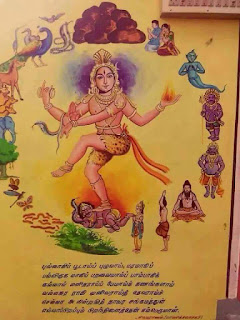Arunandi's Disconstruction of Materialism -3
Lokayata's view that intelligence is NOT primordial and categorically different but rather a byproduct of the biophysical processes is disconstructed by pointing out that there is INTENTIONALITY and Temporality as a fabric of human ( also animal) consciousness and as such it cannot be just a byproduct of the physical but organic processes in the body.
Intelligence is something not only ABOVE but also more primordial. The body is what a soul assumes, something like clothes people wear - we can discard the old and assume a new one. Of course the primary intention of the Lokayata is to DENY the reality of Karma first, karma understood here as the action-deposits lodged in the deep recesses of the mind some of which persist even when the body is dissolved and regulates the acquisition of a new body and other cognitive mechanisms during rebirth or regeneration (prapta karma).
But now another argument is put forward to circumvent the admission of Karma in the Deep Structure of the world processes underlying the reproductive mechanisms of the creature regeneration. Intelligence is seen as Gestaltic, something that emerges like the melodies of an orchestral performance, something that emerges when the body functions COLLECTIVELY and TOGETHER and hence at the disruption of which it is no more. This may be a Lokayata adaptation of the Camudaya Vada who were also positivists of a kind.
Arunandi brings to bear upon this, the EVOLUTIONARY differences among the creatures, an understanding that has been with the Tamils at least from the days of Tolkaapiyam and which has been well accommodated within Saivite thinking as seen in Manikkavasagar's CivapuraNam. This evolutionary notions may also be hidden in the VaishaNava notions of Tasavataaram, the ten fold Avatars that BEING-as-VISHNU assumes but all cloaked in mythological garb.
The point Arunandi at pains to make is that, the evolutionary differences among creatures which is an observable fact requires noting the presence of Karma in the deep structure as that which regulates creature evolution and hence the differences.
43.
aRivudaR kuNamennil aanaiyatu
aati antam eRumpataa
uRum udaR peritaanavaRril
utittidum peritaakavee
ciRuvudaR ceRi njaanamum ciRitaa
aayidum pariNaamamum
peRum udaR ciRitaavatu en peritu
aavatu en cila peecidee!
Meaning:
Now because of the incapacity (of the materialistic notions to explain the phenomenon of death at which point consciousness is totally absent and that of deep sleep or swoon in which, while there is breathing there is no self-consciousness) you Lokayata may say that Consciousness arises only because of the ORGANIZATION feature of the physical body of the creatures. Now this would mean that the creatures with large bodies like elephants and those with small bodies like the ants would have higher and lower kind of intelligence. The SIZE of the physical body must correlate with intelligence being more or less evolved but this NOT the case in the world. Furthermore the fact
that creatures have bodies of different sizes is also something that needs to be explained. Can you explain this (without recourse to the notion of Karma?)
NOTES:
The Hermeneutic perspective within which Arunandi operates enables him to disconstruct another view of the Lokayatas with respect to explaining the presence of intelligence in living creatures. The view that consciousness is a product of biophysical structure of the body was disconstructed by presenting the fact that at the point of death, something happens whereby there is NO MORE intelligence and hence consciousness while the biophysical organs may remain intact, at least in most cases of death. This led to noting intelligence as something arising because of psychophysical processes that are ultimately related to the breathing processes. But against this it was pointed out that while during deep sleep ( or in the state of swoon and so forth), the psychophysical processes particularly breathing while active there is nevertheless no consciousness.
Now emerges another candidate for the Lokayata, the materialists: the body as a whole that remains intact, while at the point of death there is disintegration as the WIND is no more while during deep sleep there is intelligence as the body as WHOLE is there.
Now Arunandi notes that this view creates problems with respect to the intelligence being higher and lower and this is NOT correlating well with size of the physical body. If intelligence is purely a matter of the WHOLENESS of the body and DIFFERENCES in intelligence is a matter purely related to the SIZE of the body, the materialists can get away with their view. However an examination of the intelligence of the creatures and body size show that this NOT always the case. In modern terms we may agree that the single-celled creatures may be very low in intelligence but when it comes to the mammals this is certainly not true. The human beings are capable of LANGUAGE and as such disclose a very high level of intelligence but their body in no way the largest among the mammals.
Now a modern lokayata may shift the body size to the size of the cranium or the brain and claim that intelligence is a matter of the size of the brain ( and its complicated internal structure) However in anticipation of such views Arunandi points that even if it is the case it DEMANDS an explanation, WHY the brain sizes differ and so forth.
Of course what is implied by this rhetorical thrust is that there is something like Karma, something
imperceptible but certainly active in the genesis of the physical body itself.
Written by,
ULLAGANAR.
( editing and re-paragraphing by his student )


